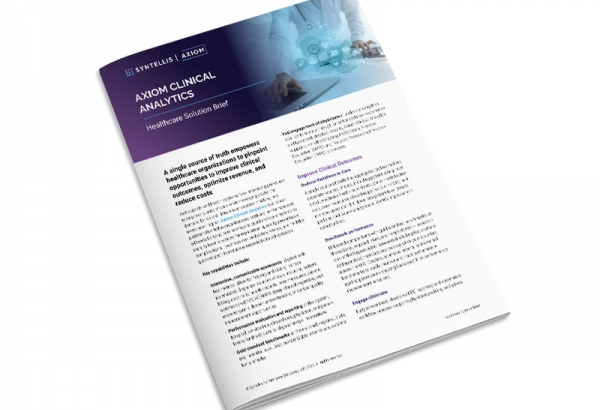Written with our strategic partner, Kaufman Hall
Faced with declining reimbursements and rising care costs, hospital and health system finance leaders are on the lookout for new areas of operations suitable for cost reductions. To date, many hospitals have focused on managing revenue streams, optimizing supply chains, and minimizing labor costs. Efficiencies have been achieved in those areas, so many hospitals are struggling to discover new ways to realize the cost savings required for value-based care.
Hospital and health system leaders should be pleased to learn that a new frontier of cost management is emerging — the integration of currently siloed data, such as cost and quality data, to inform decisions at the clinical level that can contribute to lowering costs organization wide.
During an Oct. 11 webinar sponsored by Kaufman Hall and hosted by Becker’s Hospital Review, Walter Morrissey, MD, managing director at Kaufman Hall, and Marc Stanislas, network vice president of treasury and financial services at Burlington-based University of Vermont Health Network, discussed how the six-hospital network integrated cost and quality data for informed clinical decision making to improve cost management.
Get the finance and the clinical quality teams to speak the same language
UVMHN’s leadership increased expense management for several reasons, including its involvement in Vermont’s All Payer Model ACO and a recurring trend in Vermont of expense inflation outpacing the rate increase for providers, Mr. Stanislas explained.
“We’ve been able to keep up with the [revenue trend] with volume opportunities, but those are going to be very limited going forward,” Mr. Stanislas said. “Before, we had both eyes on the revenue cycle component … but we wanted to transition one of those eyes to focus on expense management and how that relates to quality and patient outcomes.”
Since cost management can often include making difficult decisions, UVMHN knew it needed reliable, actionable data and analytics to encourage physician buy in and ensure the health system was taking a fully informed approach to optimizing care delivery.
UVMHN decided to integrate finance and quality — the two teams and two datasets especially responsible for the successful transition to value-based care.
“Up to this point, we had used the cost accounting and decision support system embedded in our EHR as our source of data. The quality data was not in that system, so we worked with the quality team and the vendor to put all the data into the same system,” Mr. Stanislas said. He adds that marrying the two datasets into one single source gave the health system a way to benchmark providers and hospitals, identify cost reduction opportunities, and enable leaders and clinicians to provide improved, data- and analytics-informed services.
Dr. Morrissey added that analysis of integrated quality and cost data allows the finance and clinical quality teams to “speak the same language” and work together to drive care optimization.
One example of UVMHN’s use of integrated cost and quality data to inform decisions is a physician scorecard that tracks several standard quality and finance measures, including patient volume, severity of illness, 30-day readmission rates, length of stay, total operation costs, supply costs per case, pharmacy costs per case, and the number of complications.
This scorecard is then used by finance and clinician leaders to track and compare physicians internally and externally to understand any inefficiencies and adjust, Dr. Morrissey explained. “This type of report allows service line leaders, department chairs, and hospital leadership to monitor and track performance of various initiatives, whether supply cost-related or pharmacy-related,” Dr. Morrissey said.
Since the reports provide data, benchmarks, and case-specific information, physicians often adapt their practices more rapidly, as appropriate, Mr. Stanislas added.
The four steps to achieving clinical transformation with integrated data
Leadership teams need to take numerous steps to integrate cost and quality analysis to inform clinical decisions and achieve clinical transformation, explained Dr. Morrissey.
#1 — Optimize enterprise planning platform
Organizational leaders must first optimize their financial planning and analysis platform. This initiative involves creating a standard platform that integrates data from legacy systems into one place. The standardized platform provides the fundamental backbone that can drive organizational improvements.
#2 — Conduct management analytics
During this stage, hospital and health system financial and clinical teams must focus on performance reporting and data analytics to provide management with a comprehensive performance assessment. Once management has this information, leaders can use it to compare their hospital’s performance with other facilities in their health system or to national averages.
#3 — Ensure cost and decision support
This stage informs data-driven decisions. Hospital and health system managers review additional internal cost savings or clinical opportunities, such as with contracts and service lines, using cost accounting and clinical performance measures. Management gain insight into cost and profitability trends to determine improvement opportunities.
#4 — Drive clinical transformation
“This step is moves an organization’s management team from informed decision making to improved patient outcomes and cost,” explained Dr. Morrissey. At this stage, hospital teams combine cost and quality analysis and dig deeper into analytics with physician scorecards and clinical benchmarks. Reliable data help leaders identify issues in clinical performance and opportunities for improved efficiency.
During the clinical transformation process, leaders must simultaneously look at processes from a global, top-down approach as well as a more internal, bottom-up approach to achieve the greatest success, Dr. Morrissey added.
The advantages of combining data-driven support with clinical transformation
UVMHN’s transition is relatively young, but Mr. Stanislas indicated the hospital’s leadership team already has made data-driven decisions to drive change in its orthopedics program. Use of integrated data and analysis allowed the network to right-size its program using a more informed approach.
Dr. Morrissey explained that financial advantages also emerge from embracing quality and process improvements from previously siloed data. Health systems can expect cost savings, cost avoidance, additional revenue, and a competitive advantage.
“Organizations can take what was previously disparate data and create a single source, ultimately having the finance and quality offices in lockstep to drive organizational change,” Dr. Morrissey said.
Most providers nationwide have picked “the low-hanging fruit” for cost savings, optimizing their supply chains and revenue cycles while maximize labor efficiencies and shared service savings. However, the integration of cost and quality data to inform clinical decisions and drive process improvements will drive the next frontier of cost management and will position providers for success with value-based care delivery.
You also might be interested in...

Axiom Clinical Analytics

4 Essential Strategies for Cost Containment in Healthcare


